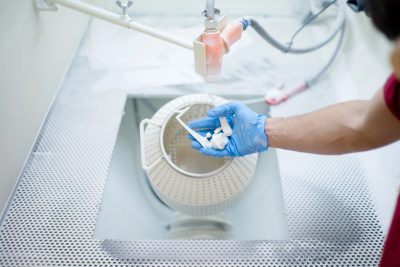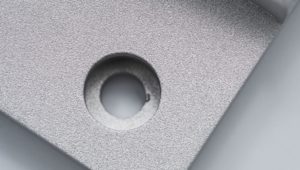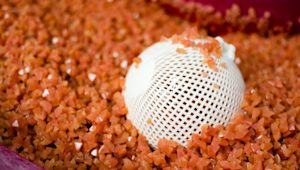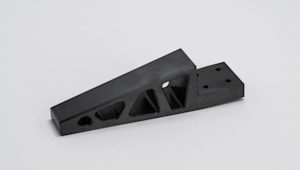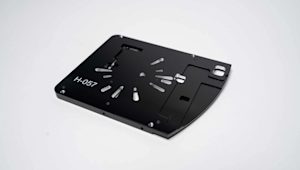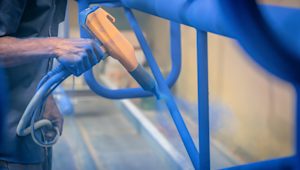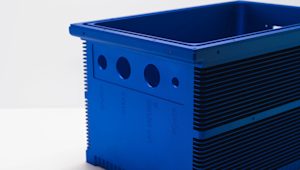Selective laser sintering (SLS) and Multi Jet Fusion (MJF) are exciting and robust 3D printing technologies capable of manufacturing accurately detailed and complex parts without the need for support material. In general, parts produced via SLS and MJF are fit for end-use, though applying a post-process to your parts can elevate their overall quality in many respects.
There is a wide range of post-processing techniques and finishes available for SLS and MJF 3D printed parts. Manufacturers often add coatings to SLS parts in particular to improve their performance. As well, adding a functional coating can sometimes help to compensate for the lack of feasible material grades available to SLS and MJF.
In this article, we’ll cover the most common post-processing methods for SLS and MJF parts currently available on the Protolabs Network platform. Ready to get your parts into production? Get an instant quote today, or read on for more on post-processing.
Curious about the cost and available material options for SLS and MJF?
How do you dye SLS and MJF parts?
The fastest and most cost-efficient method to add color to SLS and MJF parts is by dyeing them. SLS and MJF parts are porous, which makes them ideal for dyeing.
To dye a part, immerse it in a hot color bath - a large range of colors is available for SLS parts, with more color options on the way for MJF. Using a color bath ensures that you cover all internal and external surfaces of the part. Typically, the dye only penetrates the surface down to a depth of around 0.5 mm, which means that over time the color will fade and expose the original color of the powder. So, watch for wear and tear.
Pros
Cons

How does chemical vapor smoothing work?
Chemical vapor smoothing enhances part performance and aesthetics. This seals surfaces, making it easier to dye and certify for contact with skin and food while maintaining dimensional accuracy. Chemical vapor smoothing isn’t restricted by line-of-sight only, unlike other post-processing methods. As well, you don’t end up with any fixture marks.
It’s important to note that while chemical vapor smoothing re-distributes surface material to provide a sealed, smoothed surface, it doesn’t create a polished surface. Your part’s surface topology will still be visible, as well as its minimal layer lines.
Pros
Cons

How do vibro polishing and tumbling affect SLS and MJF parts?
As SLS and MJF parts are printed using nylon powder, completed parts will have a coarse surface finish. Vibro polishing smoothes out the surface of the part via a tumbler filled with small media (generally ceramic beads) that vibrate against the surface of the model, removing the grainy texture. This method gives your part a smooth and slightly shiny appearance, similar to injection molded parts.
It’s important to note that vibro polishing and tumbling affect the part dimensions and round out otherwise sharp edges. We don’t recommend using a tumbler for parts with fine details and intricate features. Smaller, weaker parts are likely to be damaged after being exposed to vibrating media for several hours. As well, small ceramic beads may get stuck inside medium-sized gaps and trenches.
Pros
Cons
Vibro polishing and tumbling quality breakdown
| Finish | ★ ★ ★ ★ ☆ | |
|---|---|---|
| Tolerances | ★ ★ ★ ☆ ☆ | |
| Speed | ★ ★ ★ ☆ ☆ |


What is the standard finish for SLS parts?
The standard finish is your default for SLS printed parts. With this process, you remove parts from the build chamber and use compressed air to get rid of all the excess powder material. After this, you clean the surface via plastic bead blasting to remove any unsintered powder that may still stick to the surface.
This standard finish is inherently rough, similar in feel to medium grit sandpaper (satin-like matte that’s slightly grainy). However, it’s the best surface preparation for painting or lacquering your parts.
All SLS parts come with this standard finish unless otherwise specified.
Pros
Cons
Standard finish for SLS quality breakdown
| Finish | ★ ★ ★ ★ ☆ | |
|---|---|---|
| Tolerances | ★ ★ ★ ☆ ☆ | |
| Speed | ★ ★ ★ ☆ ☆ |

Are spray painting and lacquering viable options for SLS and MJF?
Other options for SLS and MJF parts include spray painting and lacquering. For both types of parts, you can spray paint them or coat them with lacquer (varnish or clear coat). Via lacquering, it’s possible to obtain various finishes such as high gloss or metallic sheen. Lacquer coatings can improve your part’s resistance to wear and tear, surface hardness and water tightness while limiting marks and smudges on its surface.
Due to the porous nature of SLS and MJF parts, we recommend that you apply four to give very thin coats to get a final finish, rather than relying on a single coat. An added benefit to this is that the finish will dry faster and reduce the likelihood of the paint or lacquer running.
__Spray painting and lacquering quality breakdown__
| Finish | ★ ★ ★ ★ ☆ | |
|---|---|---|
| Tolerances | ★ ★ ★ ☆ ☆ | |
| Speed | ★ ★ ★ ☆ ☆ |

Can you use metal coating on SLS and MJF parts?
Both SLS and MJF parts can be electroplated. Stainless steel, copper, nickel, gold and chrome (and several combinations of these metals) can be deposited on the surface of parts to increase tensile strength and electrical conductivity in shielding applications.
Pros
Cons
Metal coating quality breakdown
| Finish | ★ ★ ★ ★ ★ | |
|---|---|---|
| Tolerances | ★ ★ ☆ ☆ ☆ | |
| Speed | ★ ☆ ☆ ☆ ☆ |
How does media/bead blasting work for SLS and MJF?
Bead blasting uses rounded spherical media that impact the surface of the part, leaving a more uniform finish caused by the sphere “dimpling” the surface. This process is most often used when manufacturers require a smooth, uniform finish or a dull “satin” finish.
Bead blasting involves using a spray gun to shoot fine media in a bead or sphere to smoothen 3D printed objects.
Pros
Cons

Frequently asked questions
Is post-processing for SLS and MJF expensive?
While all post-processing options will add to the cost of your custom parts, Vapor Smoothing is the most expensive operation. In general, it will raise the cost of parts by about 30%.
How does post-processing affect tolerances for SLS and MJF parts?
Isotropic finishing techniques tend to have minimal effect on part tolerances.
How does post-processing affect lead times for SLS and MJF parts?
Secondary finishing methods will have an impact on lead time. Vapor smoothing and dyeing tend to take longer than media blasting, which is one of the quicker post-processing methods.
Does post-processing make SLS and MJF parts air and water tight?
A correctly-sintered SLS or MJF part (printed in PA 12) will have some inherent water resistance, and you can apply coatings to enhance this. Silicones and vinyl-acrylates likely provide the best results, while polyurethane is not recommended for waterproofing. If you’re going for complete water resistance, we recommend a dip coating method. As well, an MJF part with a wall thickness over 4 mm is inherently watertight.
Does post-processing restrict the design of parts?
As a rule of thumb, we recommend avoiding features below 2 mm thick. The media used on tumbling or media blasting will degrade these features. If your part has assembly requirements involving sharp corners, post-processing may round out these corners. And remember to avoid using level features or including living hinges in your design if you plan to use vapor smoothing.






